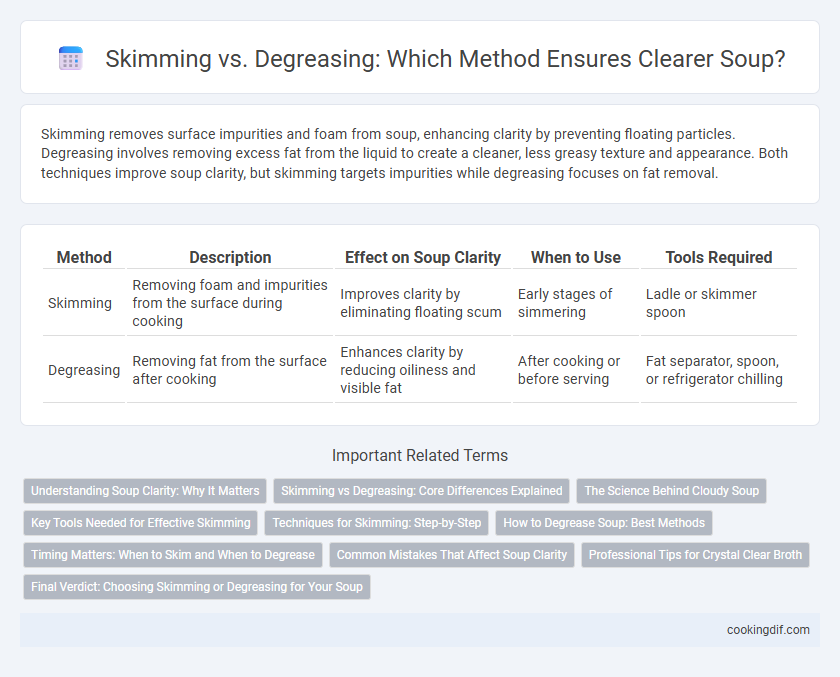Skimming removes surface impurities and foam from soup, enhancing clarity by preventing floating particles. Degreasing involves removing excess fat from the liquid to create a cleaner, less greasy texture and appearance. Both techniques improve soup clarity, but skimming targets impurities while degreasing focuses on fat removal.
Table of Comparison
| Method | Description | Effect on Soup Clarity | When to Use | Tools Required |
|---|---|---|---|---|
| Skimming | Removing foam and impurities from the surface during cooking | Improves clarity by eliminating floating scum | Early stages of simmering | Ladle or skimmer spoon |
| Degreasing | Removing fat from the surface after cooking | Enhances clarity by reducing oiliness and visible fat | After cooking or before serving | Fat separator, spoon, or refrigerator chilling |
Understanding Soup Clarity: Why It Matters
Skimming removes impurities and foam from the surface during cooking, significantly enhancing soup clarity and flavor by preventing cloudiness. Degreasing focuses on eliminating excess fat after cooking, which reduces greasiness but does not affect the initial clarity achieved through skimming. Understanding the distinction between skimming and degreasing ensures a clear, visually appealing soup that highlights the purity of its ingredients.
Skimming vs Degreasing: Core Differences Explained
Skimming involves removing impurities and foam from the surface during cooking to achieve a clearer soup base, while degreasing focuses on eliminating excess fat after cooking for a cleaner texture and taste. Skimming improves clarity by capturing proteins and coagulated particles early, whereas degreasing targets floating oil droplets to reduce greasiness. Both techniques enhance soup quality but serve distinct roles in refining clarity and flavor profile.
The Science Behind Cloudy Soup
Skimming removes visible fat and impurities that rise to the surface during cooking, which improves soup clarity by minimizing particles that cause cloudiness. Degreasing involves chilling the soup to solidify fat, allowing it to be easily lifted off, thus reducing oily layers that scatter light and create a cloudy appearance. The science behind cloudy soup lies in suspended fat droplets and proteins that cause light diffraction, making skimming and degreasing essential for achieving a clear broth.
Key Tools Needed for Effective Skimming
Effective skimming for soup clarity requires a fine mesh skimmer or ladle and a slotted spoon to remove impurities and foam efficiently. A spider strainer allows quick surface debris removal without disturbing the simmering stock. Using these specialized tools enhances the clarity and presentation of broth-based soups by minimizing floating particulates and excess fat.
Techniques for Skimming: Step-by-Step
Skimming soup involves gently removing impurities and foam from the surface with a fine mesh skimmer or ladle, starting as soon as the soup begins to simmer. To achieve maximum clarity, perform multiple skimming passes every few minutes, ensuring that floating particles and fat are removed without disturbing the broth's clarity. Degreasing complements skimming by chilling the soup briefly to congeal fat on the surface, which can then be easily lifted off to further enhance a clear and clean soup appearance.
How to Degrease Soup: Best Methods
Degreasing soup effectively enhances clarity and flavor by removing excess fat from the surface. The best methods include using a ladle to gently skim the fat, employing a fat separator to pour off broth while retaining grease, or chilling the soup to solidify fat for easy removal. Paper towels can also be lightly applied to absorb floating grease without disturbing the soup's ingredients.
Timing Matters: When to Skim and When to Degrease
Skimming soup early during the cooking process removes impurities and foam that cloud the broth, enhancing clarity and flavor. Degreasing is best done after cooling or chilling the soup, allowing excess fat to solidify on the surface for easy removal. Timing matters because skimming at the beginning maintains broth transparency, while degreasing at the end ensures a cleaner, less greasy finish.
Common Mistakes That Affect Soup Clarity
Skimming and degreasing are crucial steps to achieve clear soup, yet common mistakes often compromise clarity, such as failing to remove foam or fat during cooking. Over-skimming can disrupt the soup's flavor and body, while under-skimming leaves impurities that cloud the broth. Using a fine mesh skimmer and cooling the soup to remove solidified fat ensures a clean, transparent finish essential for high-quality broth.
Professional Tips for Crystal Clear Broth
Skimming soup during cooking removes surface impurities and foam, preventing cloudiness and enhancing broth clarity. Degreasing involves chilling the soup and carefully lifting off solidified fat, which reduces greasy texture and improves visual appeal. Combining both techniques ensures a crystal-clear broth with a clean, refined flavor ideal for professional culinary standards.
Final Verdict: Choosing Skimming or Degreasing for Your Soup
Skimming removes surface impurities and foam during cooking, enhancing immediate soup clarity and flavor, while degreasing extracts excess fat after cooking to create a cleaner, lighter broth. For lighter, clearer soup with a silky texture, degreasing offers a more refined finish, especially in broths and consommes. Choose skimming for quick impurity removal during simmering, and degreasing when prioritizing low fat content and long-lasting clarity.
skimming vs degreasing for soup clarity Infographic

 cookingdif.com
cookingdif.com